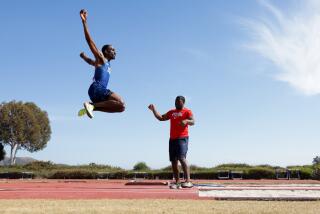Science / Medicine : ‘Talking’ Glove Brings High-Tech Help to Deaf-Blind
- Share via
PALO ALTO — A “talking” glove and a mechanical hand have been developed by engineers at Stanford to allow deaf and deaf-and-blind people to communicate more effectively with similarly handicapped people and with hearing and sighted people.
The new technologies, which have been shown to work in the laboratory, promise more independence for deaf and deaf-blind people because they eliminate the need for human interpreters. The instruments can also be hooked up to computers and modems for the transfer of information over telephone lines.
The glove and the mechanical hand have been developed independently for different uses, but they can be combined so that deaf-blind people can communicate with one another. The glove can be used to send messages, while the hand can be used to receive them.
The talking glove looks like a golf glove except that the fingertips are removed and it has sensors on the back. A person wearing the glove can “speak” to a hearing person. The glove, worn on the right hand, converts manual finger-spelling into synthesized speech which, at the moment, is played back over a small pendant-like speaker worn around the neck. It can be concealed under clothing.
A hearing person uses a small keyboard to reply to the handicapped person. Messages from the keyboard are displayed on a small screen so that they can be read by the deaf person or on a portable Braille display so that they can be understood by a deaf-blind person. The display screen is worn on the left arm. The screen can be the size of a wristwatch or larger so that it can be read by the partially sighted.
The Braille display and the digital display mean that the deaf and the deaf-blind can use the system to communicate with each other, not just to a sighted and hearing person. People who could once talk but who have lost their voice could also use the glove.
Sensors in the glove measure the angle of each finger joint. Each position of the fingers represents a letter or a number. A computer decodes the letters and numbers, depending on the finger positions. The individual characters are stored until a word is formed. A hand movement is used to send the word to the speech synthesizer or to the two displays.
At present, the finger positions are fed into a personal computer, but a microcomputer will be designed that can be worn easily by the deaf and the deaf-blind. Infrared signals and radio waves, rather than wires, will be used to carry information between the parts of the system. Also, the system will be developed to use sign-language as well as individual letters.
The glove has been tested successfully with several deaf and deaf-blind people in California. More trials are planned. “We believe the system will end the frustration that many deaf, deaf-blind and non-vocal people have in dealing with hearing and sighted people,” said the designer, Jim Kramer of Stanford.
The glove also can be used to dictate the position of the fingers on the mechanical hand, called Dexter, which has been developed at Stanford and at the Veterans Administration Medical Center in Palo Alto. A deaf-blind person “reads” by feeling the position of the fingers. The fingers can be moved electronically into the 26 positions of the one-handed manual alphabet that is commonly used in the United States. According to David Jaffe of the Veterans Administration, the hand could be programmed for different versions of finger-spelling.
The hand, Jaffe says, will introduce the deaf-blind to almost any electronically encoded information, including telecommunications and public data bases. The hand finger-spells in response to messages entered into a computer. In this way, able-bodied people who don’t know finger-spelling will be able to communicate with the deaf-blind.
The latest version of Dexter, Dexter II functions through motors pulleys and cables. The hand can spell up to four characters a second--almost as fast as communication between a human finger-speller and a deaf-blind person.






